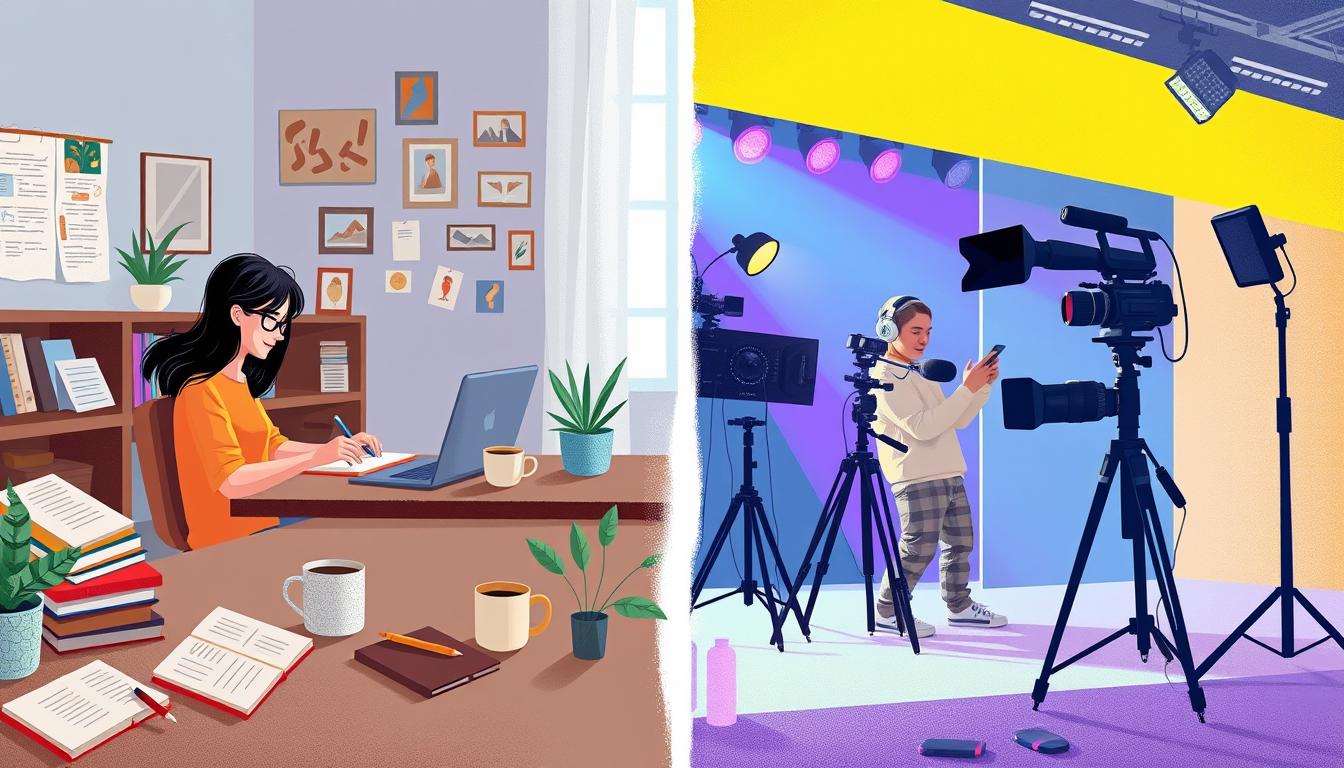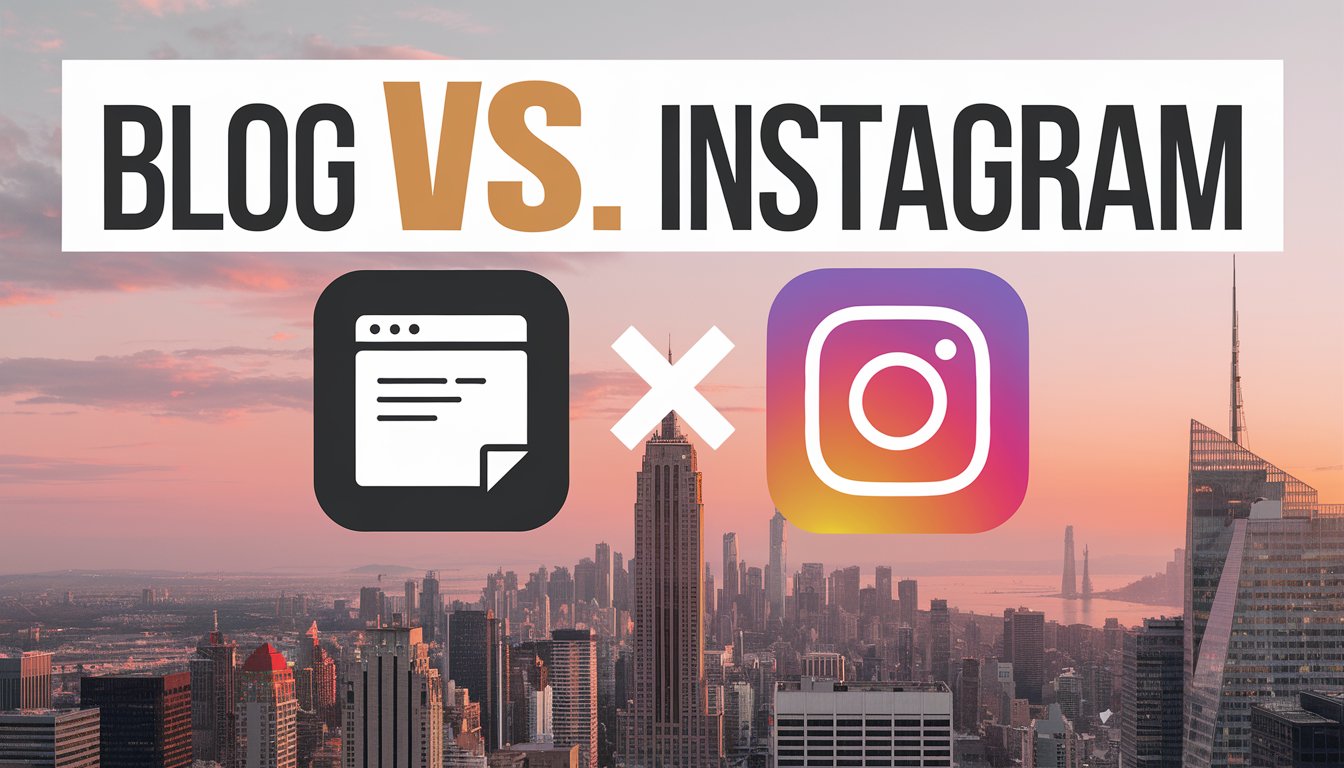What’s the Difference Between Blogging and Vlogging
In the world of content creation, blogging and vlogging are two big names. They have changed how we engage with online content. With blogs on over 600 million websites and people watching videos for 100 minutes a day, both are huge in the digital world.
Both blogging and vlogging share information, thoughts, and experiences. They use different ways to grab attention and share messages. Let’s look at how these platforms shape our online world and how they engage audiences.
Blogging: A Versatile and Accessible Platform
Blogging has been a key part of online content for over 20 years. It’s a place to share stories and guides. Blog posts help websites connect with readers through words and images.
Starting a website often begins with a blog. Platforms like WordPress make it simple to start writing and sharing. Blogging is flexible, letting you write about anything that interests you or your readers.
Blogging is very powerful for businesses. Companies that blog regularly see a 126% increase in leads compared to those that don’t. This shows how important regular, quality content is for growing a business.
Blogging is easy to get into, unlike video content, it needs special equipment and skills. You just need to know how to write. Blogging also lets you design your website and content to fit your style and brand.
Vlogging: Connecting Through Visual Storytelling
Vlogging has become very popular online. It lets people share their lives, knowledge, and creativity through videos. YouTube and TikTok are where many vloggers share their work and connect with fans all over the world.
Adam Kontras posted the first vlog on January 2, 2000. Since then, vlogging has grown significantly. YouTube alone gets 500 hours of video every minute, which shows how competitive it is.
Vloggers make money in different ways, like ads, sponsorships, and selling merchandise. Some even make more than bloggers. To succeed, you need to make great content and talk to your viewers often. Comparing blogs and videos shows vlogs are better for tutorials and demos.
Since 50% of video watching happens on mobiles, and 92% of mobile viewers share videos, vlogging is a great chance for creators. Whether you’re sharing your day or giving tips, vlogging is a powerful way to reach and engage with your audience.
Key Differences Between Blogging and Vlogging
Blogging and vlogging are two popular ways to share content and connect with audiences, each with its unique approach. Here are the key differences between the two:
| Aspect | Blogging | Vlogging |
|---|---|---|
| Format | Written content with images | Video content |
| Engagement | Builds trust through expertise | Personal connection with viewers |
| Start-Up Needs | Low-cost, minimal equipment | Higher cost, cameras, and editing |
| Content Creation | Quicker to produce | Time-intensive (filming/editing) |
| Monetization | Ads, affiliate links, e-products | Sponsorships, ads, merchandise |
Both formats are valuable for building personal brands and generating income. Blogging is easier for beginners, while vlogging provides stronger visual engagement.
Pros and Cons of Blogging
Blogging offers a range of benefits, making it an attractive option for content creators. Here are the pros and cons to consider:
Pros of Blogging:
- Affordability: Blogging is cost-effective to start. All you need is a laptop and an internet connection. This makes it accessible for anyone who wants to begin without a large upfront investment.
- Flexibility: Bloggers can work from anywhere, at any time. This is especially appealing to travel lovers and digital nomads who can write from virtually any location.
- SEO Benefits: Well-crafted blog posts can rank high in search engine results, helping you attract more organic traffic. With the right approach, your blog can become a valuable source of visitors over time.
- Ease of Setup: Setting up a blog is relatively easy, especially with the right tools and guidance.
Cons of Blogging:
- Time and Effort: Creating high-quality blog content requires significant time, effort, and skill. It’s not just about writing but also about researching, editing, and ensuring the content resonates with readers.
- Competition: The blogging space is crowded, and standing out, especially for beginners, can be challenging. It takes time to build authority and gain a loyal audience.
- Long-Term Commitment: Success in blogging is rarely instantaneous. It requires consistency and dedication over the long haul, and building a substantial audience can take years of continuous effort.
Pros and Cons of Vlogging
Vlogging offers an exciting way for content creators to engage with audiences and grow their brands. Here are the pros and cons of vlogging:
Pros of Vlogging:
- Massive Audience Potential: Over 44% of internet users watch vlogs every month, making it an excellent platform for expanding your reach and connecting with a global audience.
- Personal Connection: Vlogs allow content creators to connect with viewers on a more personal level. The visual and dynamic nature of video makes content more engaging and relatable.
- Creative Flexibility: Unlike traditional blogging, vlogging is highly visual. It provides the opportunity for creative video production, which can be a powerful way to stand out and keep your audience interested.
- Monetization Opportunities: Vlogging offers multiple revenue streams, including ads, sponsorships, affiliate marketing, and more. With 85% of businesses using video for marketing, the potential for collaborations is vast.
- Platform Reach: YouTube, the second most visited website globally, is a prime platform for vloggers. It provides access to a massive audience and offers tools to help creators grow and monetize their content.
Cons of Vlogging:
- High Startup Costs: Getting started with vlogging can be expensive. The need for quality video equipment — such as cameras, microphones, and editing software — can make it a costly endeavor, especially for beginners.
- Skill and Time Requirements: Vlogging demands specific skills, such as video editing, scripting, and on-camera presence. Creating high-quality content takes more time than writing a traditional blog post.
- Platform Dependence: Vloggers often face challenges due to algorithm changes on platforms like YouTube or TikTok. These shifts can impact visibility and audience growth, making it harder to predict success.
- Niche Competition: The vlogging space is highly competitive, so choosing the right niche is crucial for standing out. Developing a unique style also plays a key role in building a loyal audience.
Choosing Your Medium: Blogging or Vlogging?
Deciding between blogging and vlogging depends on your skills, resources, and goals. Blogging is perfect for detailed content. It helps grow your SEO and email list. I’ve written over 700 blog posts, showing it’s quicker than making videos.
WordPress and Medium make starting a blog easy. Vlogging, however, is great for visual storytelling. It helps you connect with your audience and build trust fast. I’ve made 250+ videos in four years, showing it’s a good way to share your personality.
Vlogging needs a good camera, editing tools, and creativity. Your content strategy should match your audience’s preferences. If they like reading, blogging might be better. For those who prefer visuals, vlogging is the way to go.
Some creators use both formats to reach more people. Blogging takes about an hour per post. Vlogging, however, can take 10-12 hours.
How To Get Started in Blogging
Starting a blog is an exciting journey. First, pick a blogging platform like WordPress. It’s easy to use and lets you customize a lot. Next, choose a reliable website hosting service. This keeps your blog online and fast for readers.
Create a content calendar to plan your posts. This keeps you organized and consistent. Decide on your blog’s focus and brainstorm topic ideas that fit your niche. Remember, quality content is key to attracting and keeping readers.
Invest in essential tools to improve your blogging. Use SEO plugins to optimize your posts for search engines. Grammar checkers like Grammarly can help polish your writing. Don’t forget about image editing software to create eye-catching visuals for your blog posts.
Promote your blog through social media and email newsletters. Consider guest posting on other blogs to expand your reach. With dedication and the right strategies, you can build a successful blog that engages readers and generates income.
How To Get Started in Vlogging
Are you ready to start vlogging? First, get the basics right. You’ll need a good camera or smartphone, a microphone, and proper lighting. Then, learn to edit your videos well. Tools like iMovie or Adobe Premiere can make your content shine.
Plan what you want to say in your videos. Write scripts or outlines to keep things on track. Adding extra footage can make your videos more interesting. Remember, telling a good story is key to connecting with your audience.
After you’ve made your video, it’s time to share it online. Post it on YouTube, Instagram, and TikTok. Make sure your titles and descriptions are easy to find. Talk to your viewers and work with other creators to grow your channel.
Being consistent is important. Post videos regularly to keep your audience coming back. As you grow, look into making money from your videos. With hard work and creativity, you can become a part of the booming creator economy. Experts expect it to hit half a trillion dollars by 2027.
The Future of Blogging and Vlogging
The digital marketing world is changing fast. Content creation trends are shaping blogging and vlogging. Both are adapting to new user needs and tech advancements. Blogs now use more multimedia, like videos and audio, to engage more people.
Vlogging is becoming more popular, with YouTube and TikTok leading the way. Every day, people watch about 5 billion videos on YouTube. This rise in video watching is making more people and businesses consider vlogging as a marketing tool.
The difference between blogging and vlogging is fading. Creators often mix both to reach more people. This mix lets them use the best of each medium, meeting different audience needs. As digital marketing keeps evolving, we’ll see more AI tools, personalized content, and interactive features in both.
Whether it’s blogging or vlogging, the key is being real, focusing on a specific niche, and being ready to adapt. As search engines and social media change, creators need to be quick to adjust. They should find new ways to connect with their audience in this fast-changing digital world.
Conclusion: Embrace Your Strengths and Start Creating
Whether you choose blogging, vlogging, or a combination of both, the key to success lies in understanding your strengths and connecting with your audience. Blogging provides flexibility and SEO advantages, while vlogging offers a powerful way to engage through visuals and personality.
Both mediums demand consistent effort and adaptability. However, the rewards — audience growth, monetization opportunities, and creative fulfillment — are well worth it.
Take the time to explore which format aligns with your goals and resources, and don’t be afraid to experiment with both. In the ever-evolving world of content creation, there’s room for every creator to find their voice and make an impact.
Curious about which path suits your goals? Explore more in-depth insights and strategies to elevate your online presence. Visit After Social for expert tips and guides that empower you to succeed in the digital space! Start today and let your creativity shine!





